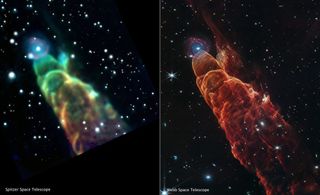NASA’s James Webb Space Telescope (JWST) has snapped a spectacular image of a “cosmic tornado” being burped out from a baby star.
The image reveals an outflow of hot gas from a newborn star — known as a Herbig-Haro object — situated about 625 light-years from Earth in the constellation Chamaeleon.
This stunning plume of gas, named Herbig-Haro 49/50 (HH 49/50), is a composite of images captured by two of JWST’s instruments, NIRCam (Near-Infrared Camera) and MIRI (Mid-Infrared Instrument). The colors in the image represent wavelengths of infrared light, which are invisible to the human eye.
Related: 42 jaw-dropping James Webb Space Telescope images
Herbig-Haro objects are bright, nebula-like objects, formed when jets of ionized gas ejected by newborn stars collide with surrounding interstellar material at hundreds of miles per second. The shockwave of the gas hitting this material heats the gas to immense temperatures, causing it to glow in both visible and infrared wavelengths of light, and creating the characteristic bright and bubbly appearance of Herbig-Haro objects.
They are usually found in star-forming regions — dense, gassy areas where baby stars are actively being born — and can evolve quickly on astronomical timescales, often changing in a matter of years or decades. These strange cosmic structures were first observed in the late 19th century, but were formally identified as a distinct class of objects by astronomers George Herbig and Guillermo Haro in the 1940s, hence their name. Astronomers have discovered over 1,000 Herbig-Haro objects across various star-forming regions in our galaxy so far, including the gorgeous, rainbow-tinted HH 30, imaged by JWST in February .
Herbig-Haro 49/50 was first discovered by NASA’s now-retired Spitzer Space Telescope in 2006, and nicknamed the “cosmic tornado” for its funnel-like appearance. It’s located in the Chamaeleon I Cloud complex, which is one of the nearest star-forming regions to Earth. It is thought to be a similar environment to the place where our own sun was born, more than 4 billion years ago.

In the JWST image, HH 49/50 appears as a cluster of arc-shaped shock waves, showing the movement of gas through space away from the protostar.
“Past observations of this region show that the HH 49/50 outflow is moving away from us at speeds of 60-190 miles per second (100-300 kilometers per second) and is just one feature of a larger outflow,” NASA explains in a statement.
Astronomers think that the protostar responsible for the gas outflow causing HH 49/50 is a newborn star named Cederblad 110 IRS4, located about 1.5 light-years away from HH 49/50. This protostar is a Class I protostar, which means it is a relatively young star in stellar terms, at about 100,000 years old, and often still embedded in a dense envelope of gas and dust.
“Herbig-Haro 49/50 gives researchers insights into the early phases of the formation of low-mass stars similar to our own sun,” NASA said. “The intricate features of the outflow, represented in reddish-orange color, provide detailed clues about how young stars form and how their jet activity affects the environment around them.”
This new JWST image of HH 49/50 also reveals that a fuzzy object at the top of the pillar of gas originally seen in images taken by the Spitzer Space Telescope is actually a distant spiral galaxy in the background, rather than a feature of HH 49/50 itself. Eventually, over the course of millenia, the distant galaxy will be obscured by the roiling gas of HH 49/50.
